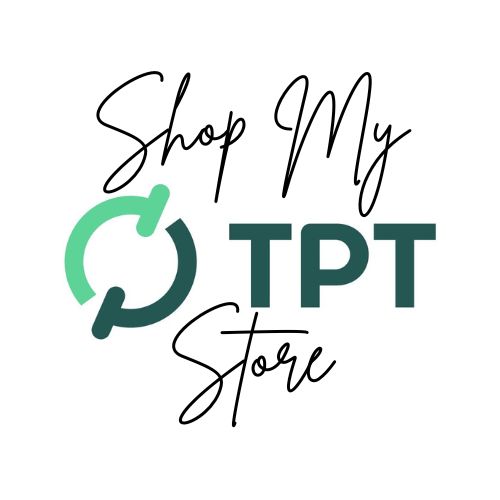In this episode, host Lisa Goodell gives tips and ideas for making class holiday parties (and alternatives) successful in special education classrooms. Examples are given using different holidays such as Christmas and Valentine’s Day.
Solutions are given for accommodating students on a limited day, when you can’t serve candy/junk food, alternative activities if you cannot have parties at all, and more. Plus, get a free class party planner with alternative ideas for each month of the year.
Note, that my next episode will focus on how to have a virtual Halloween Party during distance learning. So stay tuned for that if you would like ideas for planning a class party using Zoom, Google Meet or other live video meeting. Keep scrolling for the transcript.
Episode 20 Show Notes
Links and Resources
- Blog post that explains how Fun Friday stations work, plus an example is given.
- Games for Different Themes throughout the Year.
- Field Day Games
- Freebie: Class Party Planner with Alternative Ideas
- To sign up for Lisa’s Email List to get free ideas and strategies, use the “Subscribe” sign-up on the right sidebar of the page (or scroll down if using a mobile device).
- Lisa’s TeacherPayTeacher Store
- Lisa’s Boom Card Store
Transcript
Lisa Goodell (00:00):
Do you ever find yourself barely able to hold your head above water? Waves of IEPs, data collection, assessments, parent conferences, not to mention lesson plans and seasonal activities are all crashing around you. You need help, but not just from anybody. Grab the lifeline that is the Help for Special Educators podcast. We will equip you with creative solutions and teacher-tested strategies so you can navigate the rewarding, but difficult job as a special ed teacher. This is Lisa Goodell, your host.
Welcome to another episode of the Help for Special Educators podcast. I’m so glad to be here with you today. We are going to be talking about holiday parties, or if you can’t have holiday parties and holiday parties or activity days, I also want to give you a heads up that my next episode is going to be about holding a party virtually during a school closure. So stay tuned for that after this episode.
I know schools often allow fall and autumn or Halloween parties in October. So I thought this week I would talk about classroom holiday parties, but I’ll try to generalize it. So in case you’re listening to this at a different time of year, it will still be applicable to your situation. For the first half of my career, holiday parties were always after lunch or close to the end of the day, but then there was a year when in early December I had a TK student enroll who had a shortened schedule.
(01:50):
He got out of school at 10:00 AM. Every day. There was no way when it came to our holiday party that I wanted this TK student to miss out. So I switched our afternoon party to the morning. I was a little worried how the rest of the day would go for the older kids. However, I had absolutely nothing to worry about. The candy treats, the kids brought were put into baggies, which they took home at the end of the day. So they were not eating at school. And especially not at eight 30 in the morning, I tried more or less to keep our regular group rotation schedule going. So I had several stations for our party. Also, I had more parent volunteers that day and just about every station had an adult as I go through the list of what we did notice how I tried to include activities from different December holidays, because we had been learning about holidays around the world earlier in December.
(02:43):
So here are my stations during the party first, my mom came, she’s a retired special ed teacher and she made chocolate chip pancakes for my kids. They totally loved it. And in later years, my husband actually came and did that as well to the second station, decorated sugar ice cream cones, frosting, and candy to turn them in two Christmas trees. The third station had an adult reading a [inaudible] story. The next station had a Jewish dreidel game, an iPad [inaudible] if I’m saying that wrong, but it’s the little spinny top thing. And then you do differently things with it. We had read a book about this earlier, so the kids were really excited to play this game. Okay. The next station had a Mexican point set craft, a simple craft that they could make. And again, we had already read about the Mexican holidays and the last one, a student’s decorated either a Christmas, a Hanukkah or a [inaudible] card for their parents or guardians.
(03:42):
So we had six stations that took the whole time when the kids got there after we just did our morning routine, and then it lasted all the way 10 o’clock. When my TK student left. It was also when it would be recess for the rest of the kids. So it was great that the party was finished and then kids went to recess. So we could do some cleaning up. And then after recess, I had my normal Friday fund groups. That’s usually what we would do on Fridays. After we do our work before recess, it’s just in this case, we had our big party before recess. And so we would do review games, different activities, maybe do some more holiday stuff. And you can see a blog post where I talk about this as well, that would give a detailed description about my fun Fridays. So I was really amazed at how well the rest of the day went.
(04:31):
I really didn’t know what to expect. Cause typically kids just get hyper and even more hyper as the day progresses, especially when you’re going to have a party at the end of the day. And they know they’re going to be getting out for Christmas vacation or winter break, whatever you call it. So instead of getting more excited and hyper and rowdy about it being the last day of school, the kids actually calm down. It’s like they had their fun, they had their excitement and they loved the party, but they just kind of build out the rest of the day. We tried to just do calm activities. I didn’t try to do anything super exciting during the day. And it was just like so awesome to end this semester. That way I had no idea behavior problems that day, just everyone pretty much chilled out. So for the rest of that year and actually for the rest of my career in the classroom, because now I’m itinerant.
(05:22):
So I don’t have my own class. I kept doing parties at the beginning of the day with the same results. I just want to throw that out there to consider trying that when you plan your next holiday party, okay, my next tip is going to be about holiday party food. It depends on your school rules. Some schools, when it comes to it’s time for a party, you can bring in whatever you want. Sometimes it has to be only store bought food. It can’t be homemade food. Sometimes you can’t have sweets at all during the day. So depending on what your school allows, certainly you need to follow those rules. However, here’s the a few tips. If kids cannot have junk food during school hours, then you might ask for parents to send in healthy snacks in seasonal colors. So for example, this example is for Valentine’s day, but you can easily adjust it to fit other things for Valentine’s day.
(06:16):
I’ve asked for red and white food items to be brought in such as yogurt, apples, bananas, popcorn, cheese sticks, etc. Now I found out that some parents would never get that message from me about what to bring in. So they would send in sweet treats anyway, especially with the Valentines. So we would even make this one of the groups, perhaps the kids come to the group and the paraprofessional at that station would divide up all the candy and stuff that came in and we would put it into separate Ziploc bags. So each student got one Ziploc bag to bring the treats home at the end of the day. So again, they’re not eating all the junk food during class. They’re going to take it home and eat it. Of course, that doesn’t mean that they’re not going to start munching on their way out of school, out the Gates or on the bus home.
(07:04):
But you know, you can’t really prevent that from happening. If they can have some traits, you can just give them a small portion of all the traits and then bag the rest to send home. So yeah, you don’t have to feel like you have to have 10 different kinds of candy that the kids are all getting during your party and they’re going to eat it all. You know, like in 10 minutes you don’t have to do it that way. Okay. So my next area of talking is going to be unhealthy day parties. This is if your school doesn’t allow traditional parties in any way, like for Halloween, Christmas, winter, or whatever, you might plan alternative activities for whatever season you’re in. For example, my school district, where I taught for 20 years, they had winter break, Christmas break. However, we could still have activities for Christmas and other December holidays during the last time, but always check with your administration to know what your local school policies include, because if you’re a new teacher and most of the teachers have been at your school before that things will come up during the year that they don’t talk about in the staff meeting, they just assume everybody knows, like when it comes time for things for carnival who does what station who’s always in charge of what, what grade level does this, that and the other.
(08:15):
So you need to learn to ask questions about things because they might not remember to go through and explain, and this might be an area where that might happen. You don’t want to end up getting in trouble or reprimanded for having something at a party that you had no idea you couldn’t. So here are a few ideas thought of in case you’re in a situation where you can’t have the holiday stuff, you probably will have other ideas as well, especially if you’ve had to live through it. I have not actually had to live through that. So hopefully these will just help you think of even better ideas. Also, if you’ve had to do on holiday parties, please, you lied to me and let me know what you’ve done, because I can more information either on my Instagram or in the Facebook group for help for special educators podcast.
(09:02):
And we can all help brainstorm more ideas. So let’s get started instead of ghosts for Halloween, maybe you would just do activities that have to do with cute pumpkins, but not even Jack Lennar’s for haunted houses. Instead of that, maybe you could do some activities focusing on football or other fall sports for Christmas. Usually Santa is okay, but just in case you can’t even do that at all. You can make a craft with a wreath and a pretend candle. You could do a point set of craft. Maybe gingerbread houses would be okay. You could have an activity or craft with a snowman instead of Santa. If he’s not allowed instead of reindeer or elves, you could have polar bears and penguins. You could also have activities which incorporate many holidays that happen during that season. Uh, another example would be to do something totally unrelated to the holiday season at all, for example, do winter sports.
(09:56):
And this is especially good on years that we have the winter Olympics, but you could even do it on yours. We don’t have the Olympics. Another idea would be to choose a random national day or week. For example, October has several science and chemistry related week. So you might have a fun science experiment week where each day you do a different activity, maybe some STEM and steam activities, and then you might cap it off with a big, huge science experiment party. That would be really fun, probably any time of year national fossil day is also in October. So maybe you could plan a dinosaur party and that could be really popular with your class. Especially with the younger grades. I’ve actually created an exclusive freebie and it’s called a classroom party activity day planner. I also added a chart giving a small sampling of the random holidays for each month.
(10:47):
For example, world smile day, clean your desk day or bingo day. So you can use that to plan stations for your next holiday party or next and holiday party or your next activity day. You might also want to check out my thematic games in my TPT store. You can find links for everything in the show notes at [inaudible] dot com slash podcast. While you’re there, you should sign up for my mailing list. That’s where I give lots more content on teaching tips for your classroom. I do my giveaways there and I always keep you informed of the newest resources I’ve put out and what’s happening with the podcast.
(11:48):
Now, when I start to get stressed or overwhelmed about school, I find it helps to take a moment to slow down, stop and focus on my breathing. Sometimes I also might say the serenity prayer aloud or in my head here it is, God grant me the serenity to accept the things. I cannot change the courage to change the things I can and the wisdom to know the difference. I might also add a few of my own words. Here’s the sample for us special educators help us to listen and truly understand our students. Please give us words, actions, and solutions, which will help in difficult situations. May our classrooms be peaceful places where teachers, staff, and students learn and thrive after that, I try to go out and find someone else to help because helping others keeps me from selfishly dwelling on my own problems. Thank you so much for listening. And I hope you heard something helpful during this episode that you can implement in your teaching. Remember, you are amazing what you do makes a difference and don’t let anyone tell you otherwise, go find someone else to encourage because they probably need to be reminded that they are amazing too.
Podcast Host: Lisa Goodell

Lisa Goodell, M.A., launched the “Help for Special Educators” Podcast on April 1, 2019. She has taught for over 24 years, including third grade, resource/inclusion (RSP), and mild/moderate self-contained (SDC). Currently, she is an itinerant orthopedic impairment (OI) specialist/teacher for students from birth to 21 years old in all general ed and special ed settings.
Lisa has a master’s degree in special education and six special ed and general ed teaching credentials. She has been honored as “Teacher of the Year” at both the elementary (2014) and secondary levels (1994). She lives in rural Central California with her family and a bunch of cats. Connect with Lisa here. You can also learn more by listening to the beginning of Episode 1.
Thank you to all my listeners for spreading the word, this podcast has been heard in 50 countries!







